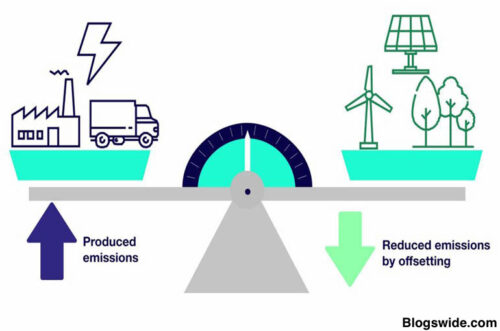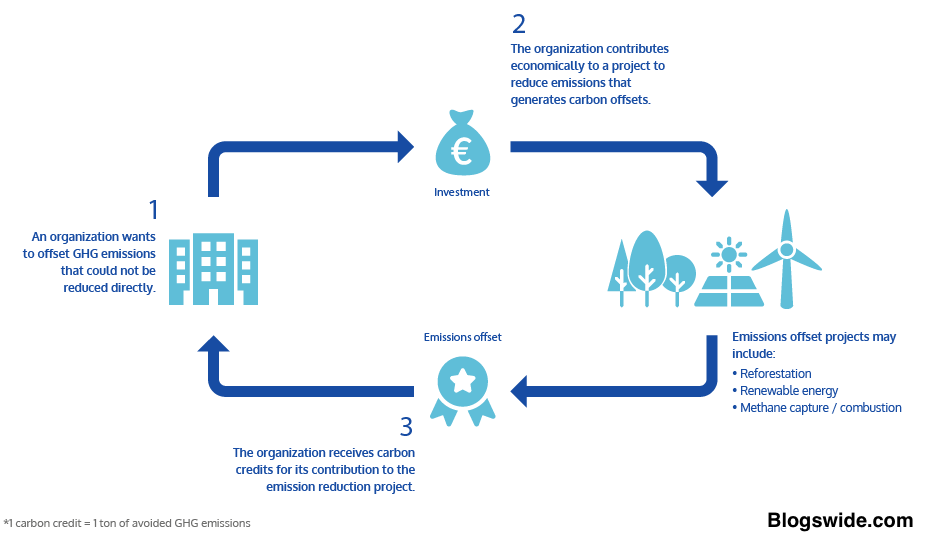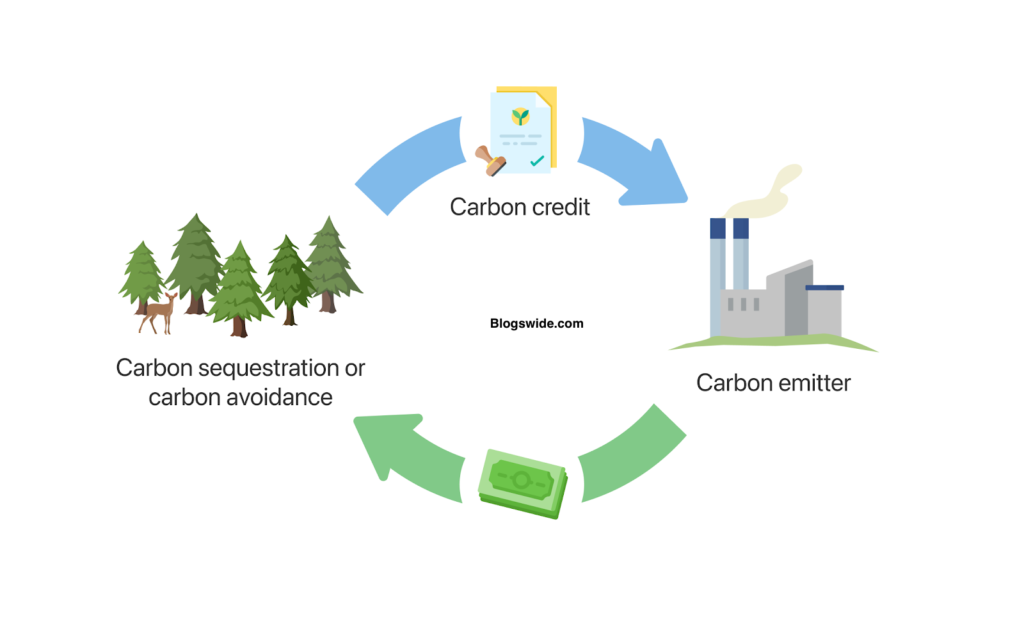What are Carbon Offsets, their benefits and limitations

Tradeable carbon offsets are linked to activities that lower atmospheric levels of carbon dioxide (CO2)? Instead of taking measures to lower their own carbon emissions, individuals or groups can purchase these certificates to fund climate change projects. As a result, the certificates “offset” the buyer’s CO2 emissions with another company’s reductions.
In simple words, if a company or person does a significant amount of carbon dioxide or greenhouse gases emission, they can launch or fund a project. Which in turn would help them in reducing the percentage of carbon dioxide in the atmosphere. This system is recognized by the administrations to keep the carbon dioxide level in the atmosphere.
There are many ways for implanting carbon offsets like building renewable energy, carbon-storing agricultural practices, reforestation, landfill and waste management. They might seem very simple but in reality, producing them is challenging work.
Table of Contents
Significance of Carbon Offsets
Carbon offsets became popularized at the beginning of the 21st century when carbon dioxide reached an alarming level. Global warming became a global matter in this century and organizations started pressing the need for stability in the environment. Controlling carbon dioxide emissions through various equivalents (CO2 e).

Graph of Carbon emissions from 2025 to 2020
Examples
- Energy Efficiency Improvements
This program focuses on the usage of fuels or chemicals that don’t generate CO2. One big representation of this method is more efficient vehicles for transportation that run on CO2 alternatives.
- Renewable Energy Projects
They are those sources which could be regenerated and used again and again. Buildings wind farms is a renewable energy projects that will replace coal-fired power plants and aid in reducing the production of CO2.
- Carbon Sequestration
Biological, technological, and geological carbon sequestration could be used in soils and forests for storing carbon in a carbon pool. (Like tree planting activities)
- Greenhouse gases supervision
Obliteration of powerful industrial greenhouse gas like halocarbons.
Estimated carbon footprints until 2049

What are Carbon Footprints?
Both directly and indirectly, a person or an institute emits carbon dioxide or other greenhouse gases (GHG). The total amount of that CO2 emission is known as the carbon footprint.
- Direct footprint emissions are those in which a person or institute is directly involved. The best example would be a vehicle owned by a person or company that emits carbon dioxide or other harmful gases.
- Indirect footprint emissions are emissions that result from the reporting person or company’s activities but don’t come from their personal belongings or entities they own. They are also referred to as upstream or downstream activities or actions.
Example
Production of clothing items
The production of clothing items creates emissions of GHGs at various junctures in the production and supply chain.
- Growing cotton from raw materials
- Shipping of raw materials
- The final generation of the product
- Decomposition of material in a trash yard
In all of the above steps, greenhouse gases are generated at different levels. Hence, contributing to both the consumer’s and producers’ carbon footprint.
Also read: Exit Navigation
Working on the carbon offsets

Carbon Offsets can be traded, bought and sold (as part of compliance schemes). Kyoto Protocol, United Nations Framework Convention on Climate Change(UNFCCC) and the European Union Emission Trading Scheme (EUETS) are some of the compliance schemes. EUETS is a regional carbon market where various European countries could trade carbon allowance to achieve regional emission reduction objectives.
A corporation of a larger scale could work with them for low costs and efficiency. Whereas an individual or minor company could pay a dealer to remove a fraction of carbon dioxide from the atmosphere. The customer measures their emission levels (there are tools available for calculating carbon emissions) and the broken then charges a fee based on that rate or level. The broker takes its fees and uses all the remaining amount to invest in an emission project.
After purchasing carbon offsets, an individual or company obtains a certificate or some other proof of similar equivalence. They can use this as proof later that they have ascertained compliance.
How carbon offsets are generated?
- Production of energy from such processes that avoid using fossil fuels. They produce energy from a clean renewable resource.
- Maintenance and healthy production of forests and wilderness for sequestering (capturing or storing) the release of greenhouse gases into the atmosphere.
- Capturing and destruction of greenhouse gas that would be emitted into the atmosphere. Seizing projects at landfills, captured the methane gases released into the atmosphere as waste material from different sources and in turn, use captured methane to produce electricity.
Benefits of Carbon Offsets

There are various benefits of carbon offset, some are listed below.
- Funds projects
If carbon setting is done rightly, it could generate huge sums for underfunded climate solutions. There are various stories of projects that have benefitted from carbon offsets, said Bronson Griscom. He’s a senior director in natural climate solutions at Conversation International.
These examples included the Costa Rican government which produced $30 million a year for forest conservation through carbon offsets credit. He used that money to conserve millions of acres of forests. Peruvian Amazon also reduced 75 per cent of reforestation by taking more than one million cars off the road every year.
- Technology developments
Due to the widespread use of carbon offsets and active criticism, many improvements are being added to carbon offsetting. GPS and drones are being used for monitoring reforestation, representation, tree plantings and forest maintenance. Direct Carbon Capture (DCC) technology is also prevailing among the corporations that are utilizing carbon offsets.
- Investment and trade advancement
Carbon offsets have thrived in the trade and the market has enticed huge levels of interest and investment. Many companies are being pressured to drive the market for offsets and there are not many proven methods to tackle carbon emissions as effectively as carbon offsets.
Limitations of Carbon Offsets
- Flawed estimates
It’s hard to calculate the precise emissions and carbon footprints as it’s a complex and flawed process. As a result, what’s said on the tin isn’t manifested in reality.
- Absence of regulation
Carbon offsetting is a wild west with low transparency and poor creation between price and credit quality. There are no set restrictions for people purchasing carbon offsets.
- Lack of consistency
To limit climate change, it’s necessary to maintain the carbon offsets credit but it varies frequently. Therefore, the emissions are unbridled and as a result, this system fails to maintain a balanced environment.
Carbon offset credits
- Flying carbon offset credits
Flying comes with a big carbon footprint and is something we all need to do from time to time. Approximately 500 pounds of carbon dioxide are emitted per passenger for every 1,000 miles of air travel.
- Individual carbon offset credits
50,000 pounds a year are the whooping carbon footprint of every American.
- Carbon credits today
$3 to $5 per ton of carbon emission is produced per day.
Conclusion
Carbon offsets have their benefits and limitations but their pros are dominant over their cons. Therefore, there is no harm in using them and benefiting the Earth. As a result of financial incentives from carbon offsets and other financial and diplomatic tools, these nations which use such methods could change their behavior to make it easier for them to adhere to binding emissions limits in the future.





